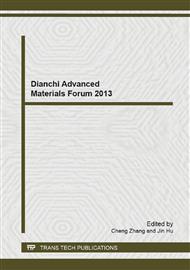[1]
Neaton JB, Rabe KM. Appl Phys Lett (2003); 82: 1586.
Google Scholar
[2]
Johnston K et al. Phys Rev B (2005); 71: 100103.
Google Scholar
[3]
Rios S et al. J Phys Condens Matter (2003); 15: L305.
Google Scholar
[4]
Shimuta T, Nakagawara O, Makino T. J Appl Phys (2002); 91: 2290.
Google Scholar
[5]
Nakagawara O, Shimuta T, Makino T. Appl Phys Lett (2000); 77: 3257.
Google Scholar
[6]
Tabata H, Tanaka H, Kawai T. Appl Phys Lett (1994); 65: (1970).
Google Scholar
[7]
Kim Juho, Kin Younggnam, Kim Young Sung, Lee Jaichan. Appl Phys Lett (2002); 80: 3581.
Google Scholar
[8]
Bungaro C, Rabe KM. Phys Rev B (2002); 65: 224106.
Google Scholar
[9]
Bungaro C, Rabe KM. Phys Rev B (2004); 69: 184101.
Google Scholar
[10]
Le Marrec F et al. Phys Rev B (2000); 61: R6447.
Google Scholar
[11]
Duan YF, Qin LX, Tang G, Chen CQ. Phys Lett A (2010); 374: (2075).
Google Scholar
[12]
Cooper VR, Rabe KM. Phys Rev B (2009); 79: 180101.
Google Scholar
[13]
Wu Tai-Bor, Hung Cheng Lung. Appl Phys Lett (2005); 86: 112902.
Google Scholar
[14]
Hung Cheng Lung, Chueh Yu-Lun, Wu Tai-Bor, Chou Li-Jen. J Appl Phys (2005) ; 97: 034105.
Google Scholar
[15]
Jiang JC et al. Appl Phys Lett (1999); 74: 2851.
Google Scholar
[16]
Yu T, Chen YF, Zhu YY, Liu ZG, Ming NB, Wu XS. Appl Surface Sci (1999); 138–139: 609–12.
Google Scholar
[17]
Zhu ZY et al. Solid-state Electron. (2006); 50: 1756.
Google Scholar
[18]
Zhu ZY et al. Chin Phys (2007); 16: 1780.
Google Scholar
[19]
Hohenberg P, Kohn W. Phys Rev (1964); 136: 864.
Google Scholar
[20]
Kohn W, Sham L. Phys Rev (1965); 140: A1133.
Google Scholar
[21]
Baroni S, Dal Corso A, de Gironcoli S, et al. Available from: http: /www. pwscf. org.
Google Scholar
[22]
Ceperley DM, Alder BJ. Phys Rev Lett (1980); 45: 566.
Google Scholar
[23]
Perdew JP, Zunger A. Phys Rev B (1981); 23: 5048.
Google Scholar
[24]
Vanderbilt D. Phys Rev B (1990); 41: R7892.
Google Scholar
[25]
Monkhorst HJ, Pack JD. Phys Rev B (1976); 13: 5188.
Google Scholar
[26]
Pack JD, Monkhorst HJ. Phys Rev B (1977); 16: 1748.
Google Scholar
[27]
Zhong W, King-Smith RD, Vanderbilt D. Phys Rev Lett (1994); 72: 3618.
Google Scholar
[28]
King-Smith RD, Vanderbilt D. Phys Rev B (1993); 47: 1651.
Google Scholar
[29]
Vanderbilt D, King-Smith RD. Phys Rev B (1993); 48: 4442.
Google Scholar
[30]
Axe JD. Phys Rev (1967); 157: 429.
Google Scholar
[31]
Zheng Y, Wang B, Woo CH. Appl Phys Lett (2006); 88: 092903.
Google Scholar
[32]
Zheng Y, Wang B, Woo CH. Appl Phys Lett (2006); 89: 062904.
Google Scholar
[33]
Zheng Y, Wang B, Woo CH. Appl Phys Lett (2006); 89: 083115.
Google Scholar


